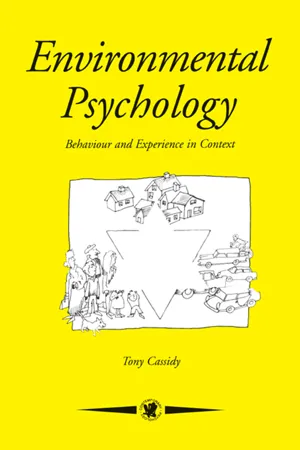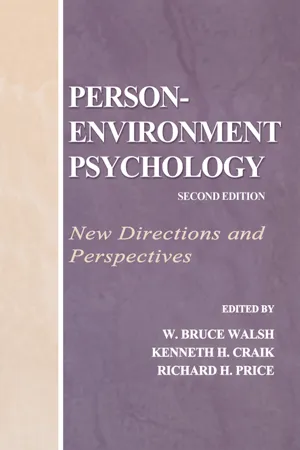Psychology
Interactionist Approach
The interactionist approach in psychology emphasizes the dynamic interplay between an individual's biological, psychological, and social factors in shaping behavior and mental processes. It suggests that understanding human behavior requires considering the complex interactions between internal and external influences, such as genetics, cognition, and social environment. This approach highlights the importance of both nature and nurture in shaping human experiences and development.
Written by Perlego with AI-assistance
Related key terms
3 Key excerpts on "Interactionist Approach"
- eBook - ePub
Environmental Psychology
Behaviour and Experience In Context
- Tony Cassidy(Author)
- 2013(Publication Date)
- Psychology Press(Publisher)
Personality and assessment, psychologists again became interested in person-environment interaction within psychology generally. The success of interactionism seems to be undecided as yet, with two reviews by the same author coming to slightly conflicting conclusions. Endler (1982) claimed with confidence that interactionism had come of age, but a year later he (1983) argued that interactionsism had some way to go before becoming a fully fledged theory. The main reason for this pessimism was that the vast majority of research did not reflect a truly interactional methodology. Often what appears as interactional is no more than an addition of person and environmental variables. However the attempt to include both person and environment in the analysis must be applauded as a development, and the difficulty in devising interactional methods acknowledged.In environmental psychology at least three different forms of integral theoretical themes focusing on variations of Lewin’s B = f(P,E) can be identified. Gifford (1987) describes these as interactionism, transactionalism, and organismic theories.Interactionism refers to a model where persons and environments are seen as separate entities, which engage with each other in various forms of interaction. To some extent it would appear that the rejection of this term in favour of transactional is partially based on the way in which interaction has been operationalised by many as the additive effect of person and environment. However interactionism does tend to suggest that individual, isolated interactions are the focus of study.Transactional emphasises the interdependence of person and environment in the process thus ensuring that additive effects are not acceptable as explanatory models. In addition it includes the notion of sequences or chains of interactions in a developmental process. As such it extends the interactional framework and is usefully applied, for example, in models of stress. - Phil Gorman(Author)
- 2020(Publication Date)
- Routledge(Publisher)
Chapter 7Spec checkInteractionist Approach to schizophrenia
The importance of an Interactionist Approach in explaining and treating schizophrenia; the diathesis–stress model.AO1 (Knowledge and understanding): What is an Interactionist Approach?
In Chapter 3 , we considered the mind–body debate, which looks at whether the mind and body are the same thing and whether it is possible for one or the other to influence our behaviour.Think!Interactionismgoes beyond this debate and suggests that not only do they both exist but they both have an equal influence on our behaviour. An Interactionist Approach is one that says that there are two (or more) influences on our behaviour and therefore we no longer need to argue about whether schizophrenia is caused by biological factors or psychological factors because, according to this approach, it’s caused by both!What are the biological factors involved in schizophrenia? What are the psychological factors?The diathesis–stress model explained
In the nature–nurture debate, the question wasn’t whether it’s nature or nurture that causes people to behave in the way that they do, it was about the relative importance of each. Consequently, there was already an acknowledgement that it isn’t possible to separate nature and nurture from each other, due to the fact that both inevitably exert some kind of influence. It’s virtually impossible to say that one is responsible for this and the other is responsible for that. We have already seen how hard it is to show cause and effect in the study of schizophrenia, as we can’t show, for example, whether it was high levels of dopamine in a person that led to the development of schizophrenia or the other way round.- eBook - ePub
Person-Environment Psychology
New Directions and Perspectives
- W. Bruce Walsh, Kenneth H. Craik, Richard H. Price(Authors)
- 2000(Publication Date)
- Psychology Press(Publisher)
person-in-environment systems are assumed to operate in a dynamic equilibrium.These holistic assumptions are consistent with the work of several other contributors to these volumes. For example, Pervin (1992) united the concepts of person and environment in his discussion of goals and their implementation through plans with their cognitive, affective, and behavioral components (psychological levels of integration). In a similar manner, Magnusson and Torestad (1992) highlight cognitive and emotional factors in the person as essential determinants of behavior and Heyman and Dweck (1992) are interested in how children respond cognitively, affectively, and behaviorally to failure situations. Although these researchers have clearly acknowledged the important role of psychological part-processes (and their interrelations) in human functioning, their approach differs from ours insofar as we also acknowledge valuative processes—an area sorely underexplored in both general and developmental psychology—as functioning in an interdependent manner with cognition, affect, and action (as an exception among the contributors to these volumes, see Nasar & Fisher, 1993, and their related work).Concept of PersonWe define the person aspect of the person-in-environment system with respect to levels of integration, and so assume that the person is comprised of mutually defining physical/biological (e.g., health), intrapersonal/psychological (e.g., self-esteem), and sociocultural (e.g., role as worker, family member) aspects. Furthermore, in line with our constructivist assumption, we regard individuals as active, striving, purposeful, goal-oriented agents capable of spontaneously structuring, shaping, and construing their environments in various ways, and acting in terms of their own experience.We also assume that human beings are characterized by a rage for order (Kuntz, 1968) and by multiple intentionality. That is, the person transacting with his or her environment has the capacity to focus on different objects of experience such as the self, an object, and the relation between both. Moreover, the person has the capacity to plan
Learn about this page
Index pages curate the most relevant extracts from our library of academic textbooks. They’ve been created using an in-house natural language model (NLM), each adding context and meaning to key research topics.


